Puto recipe (puto cheese): This one’s for the cheese lovers!
It’s been said that this puto recipe actually originated from Japan and other countries in Asia, such as Thailand, Malaysia, Indonesia, and China. But it’s a favorite in the Philippines too!
Puto is a steamed rice cake that comes in a lot of varieties, both sweet and savory.
One of the most common toppings is cheese, and it has a savory taste and melt-in-your-mouth texture.
This puto recipe will teach you how to make puto with melted cheese, and trust me, this cheese puto recipe will soon become a favorite! The secret is not to oversteam the puto so it maintains its soft and chewy texture.
Keep reading to find out how to make puto that’ll impress the whole family!
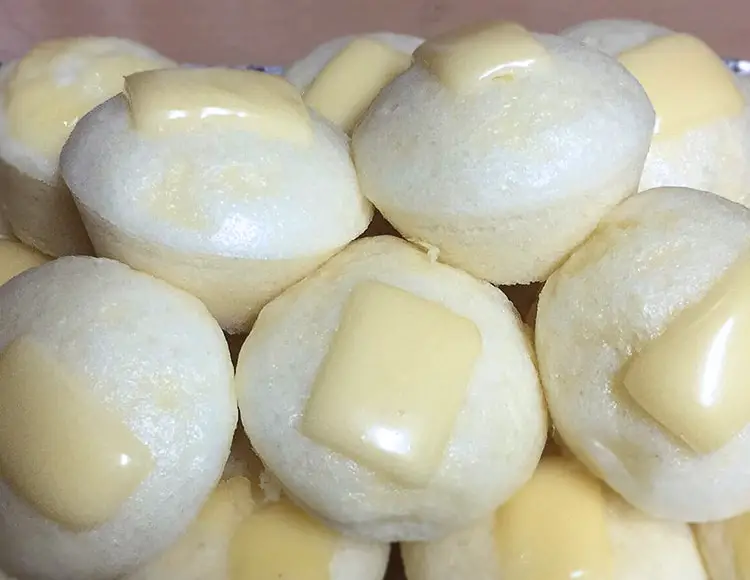
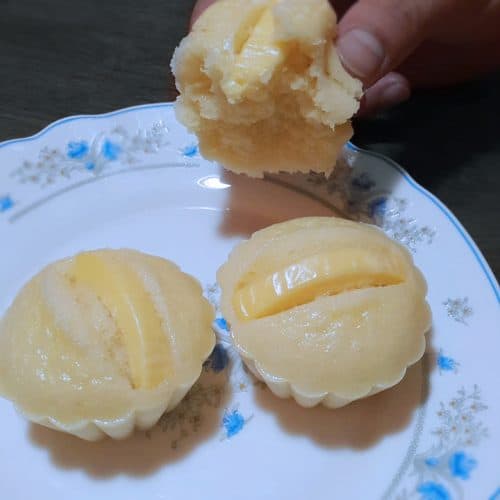

Check out our new cookbook
Bitemybun's family recipes with complete meal planner and recipe guide.
Try it out for free with Kindle Unlimited:
Read for freeIn this post we'll cover:
Filipino puto recipe (puto cheese)
Ingredients
- 2 cups rice flour
- 11/4 tsp baking powder
- ½ tsp refined salt
- 1 cup white sugar
- 1 large fresh egg
- 1 cup evaporated milk
- ½ tsp vanilla extract
- 2 cups water
- 1/4 cup butter unsalted and melted
- 36 pieces cheese cubes ( for toppings) Cheddar or Edam
- Food coloring (optional) yellow
Instructions
- Sift the dry ingredients (flour, baking powder, sugar, and salt) into a bowl. Make sure they're thoroughly sifted. Set aside.
- Beat the egg, then add the evaporated milk, vanilla extract, and water. Mix thoroughly.
- Make a hole in the center of the dry ingredients. Then pour the wet ingredients into the hole and mix continuously.
- Mix thoroughly until the texture is smooth and soft and all lumps are gone.
- If you opt for food coloring, separate the mixture, then add the color (and essence/flavor). Mix well.
- Pour into your desired mold until it's 3/4 of the way full.
- Place in a steamer and cook for 10-12 minutes and remove the puto.
- Now add 1 cheese cube on top of each cake and steam for an additional minute or 2.
- Remove from the steamer and let it cool.
- Serve with dinuguan (optional).
Nutrition
Check out YouTube user SarapChannel’s video on making puto cheese:
Cooking tips
If you’re feeling lazy, you can put each uncooked cake in your rice cooker and steam them that way or use an electric steamer.
If you want to use an electric mixer to make the batter, don’t mix at high speed, or you’ll end up with unwanted air bubbles.
It’s important to use good quality baking powder, or else your puto will have a weird taste and shape. Some puto recipes call for a bit of baking soda, but I skip it because the puto can taste a bit bitter.
You can use any kind of mold you want; just make sure it’s greased so the puto won’t stick.
If you want your puto to be extra soft, use glutinous rice flour instead of the regular one.
You can use a simple bamboo steamer for this puto recipe, and really, there’s no need for anything fancier. There’s no need to use a cheesecloth either; just place your puto molds into the steamer or steamer basket.
If you want to save some time, you can make the batter the night before and store it in the fridge. Then, the next day, you can make the steamed buns!
If you want to be sure you get the best puto texture, steam and cook on low heat. The cheese will be slightly melted but not overly liquidy.
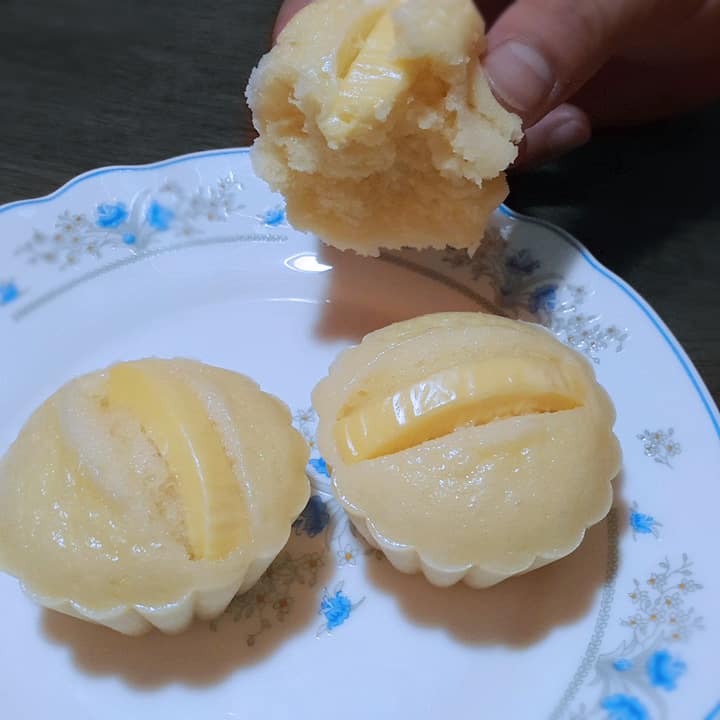
Where to get molds for puto?
There are plastic molds available at some Filipino stores, or you can purchase them online, such as on Amazon.
If you want to keep it simple though, you can just use muffin tins or cupcake liners. Also, you can use silicone muffin cups.
Substitutions & variations
If you want to make puto healthier, or you just don’t like some of the ingredients, you can make some substitutions. You can also make this dish vegan if you want!
Here’s what to substitute:
- You can skip the evaporated milk and use nut milk (almond, cashew), oat milk, soy, and coconut milk. Just make sure to add 1/2 cup more water to the recipe so the puto doesn’t become too dry.
- You can use brown sugar, muscovado sugar, or honey as a sweetener instead of white sugar.
- It’s possible to use any kind of cheese you want. If you want a stronger cheese flavor, use cheddar cheese. You can also use mozzarella, Parmesan, or any other processed cheese for this puto cheese recipe.
- To make this recipe vegan, use vegan milk and cheese, and you can also use vegan butter and egg. The recipe still works without eggs or egg substitutes, but the rice cake may be crumblier than usual.
- For flour, it’s best to use rice flour. You can find this in most Asian supermarkets. If you don’t have rice flour, you can use all-purpose flour or tapioca starch.
- Glutinous rice flour also works, but the texture will be a bit different. Some people opt for sweet rice flour, but I find that the results are a bit too gooey for my taste.
- You can also use all-purpose flour, but the texture and taste will be different from traditional puto.
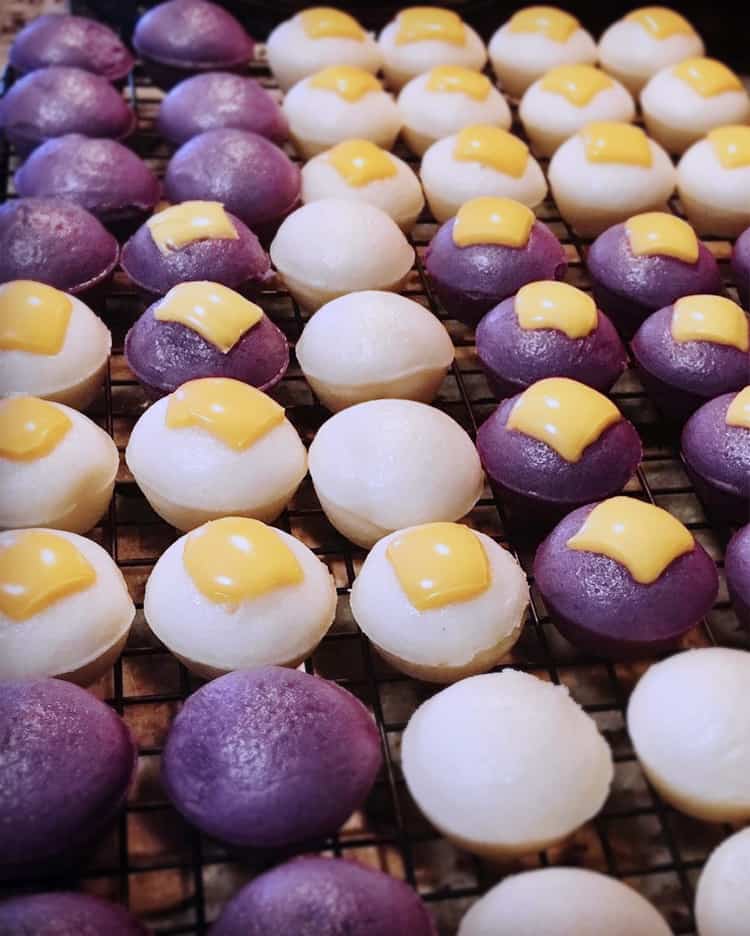
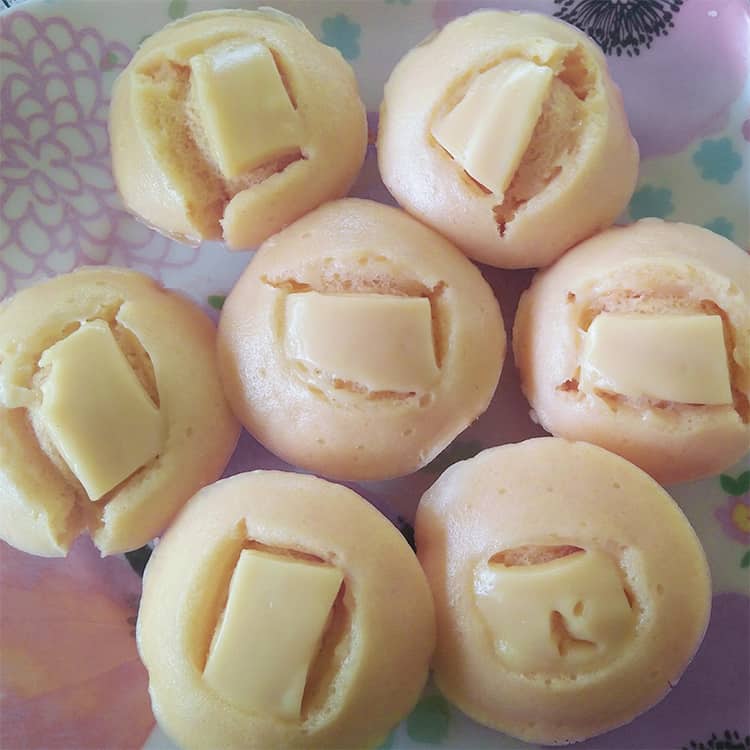
How to serve and eat
Puto is best eaten warm and it can be reheated in the microwave for 15-20 seconds.
You can eat it as is, or you can top it with butter, margarine, condensed milk, cheese, or chocolate.
Puto is served as a snack or as dessert. It can be eaten for breakfast, lunch, or dinner.
It’s a popular food to take on picnics and it’s also a popular street food.
Puto is such a versatile dish that it can be served in different ways.
The most famous combination of puto is with dinuguan (pork stew). Puto with salted egg is also one delicious variety.
If you’re serving Filipino cuisine, it’d be nice to have kutsinta, biko, puto-bumbong, bibingka, cassava cake, and sapin-sapin to partner with your homemade puto.
The best drink to partner with this is sago at gulaman. They’ll complement each other, and your guests will absolutely love this after eating the Filipino dishes you’ve served them!
After a hearty main course, puto is the best way to end a meal.
But if you want to have a variety of snacks, you can serve puto and some salted eggs on the side. Your guests will surely love this!
Similar dishes
Puto may be similar to bibingka and kakanin, but there are also other Filipino dishes that have the same properties as puto.
There are actually very many local variations of puto; some make the puto mixture sweet, some make it savory, and others combine the flavors. Puto cheese buns are just one of the many varieties you can find!
For example, there’s puto bagas, which is made with brown sugar; puto lanson, which is made with coconut milk; and puto bungbong, which is made with purple yam.
There’s a food called puto flan, and it’s a combination of 2 all-time favorite Filipino dishes: puto and leche flan. It’s made by layering leche flan on top of puto.
Puto Pao is also a popular dish. It’s a steamed rice cake that’s filled with savory meat. The filling is usually pork, but chicken and beef are also popular options.
There are various types of Filipino steamed rice cakes. These are kutsinta, biko, puto-bumbong, and sapin-sapin.
Kutsinta is made from glutinous rice flour, brown sugar, and lye water. It’s steamed and then served with grated coconut on top.
Biko, on the other hand, is a combination of glutinous rice, brown sugar, and coconut milk. It’s also steamed, and some add latik on top as well.
Puto-bumbong is made from glutinous rice that’s been soaked overnight, then it’s ground the following day. It’s steamed inside a bamboo tube and served with margarine, shredded coconut, and muscovado sugar.
And lastly, sapin-sapin is a layered kakanin that’s made from glutinous rice, coconut milk, and sugar. There are also different colors in every layer, and it’s served with latik on top.
How to store
Puto is best eaten fresh, but it can last in the fridge for up to 4 days. You can also freeze it for 2 to 3 months.
When storing, make sure to wrap it tightly in plastic wrap so that it won’t dry out. You can also store it in an airtight container.
To reheat, steaming is the best method. You can also microwave it for a few seconds, but just so you know, the texture will probably change a bit.
FAQs
Is puto cheese rice cake healthy?
Cheese puto is a relatively healthy food/snack. Each piece has about 120-150 calories, depending on the toppings and filling.
Cheese puto has approximately 120 calories. In addition, it has about 6 grams of fat, 88 mg of sodium (a bit much), and 9 grams of carbohydrates.
But puto is also a good source of vitamin A, calcium, and iron. In addition, it’s also healthy because it contains protein and fiber. H
ere are some other nutritional facts about cheese puto:
- This food is low in cholesterol, as each piece has about 30 mg. If you substitute evaporated milk with coconut milk, it’s even healthier.
- Since the dish is steamed, it doesn’t require the use of oil, and it’s not greasy.
- Rice flour converts into energy for the body.
So you can enjoy eating puto while getting the health benefits it gives!
Can you bake puto instead of steaming?
You can steam-bake puto in the oven. The process is pretty much the same as steaming puto on the stovetop.
On the oven’s top rack, place your muffin tray on top of the sheet or pan with boiling water. By now, the water ought to be steaming.
Bake in the steam setting for 18 to 20 minutes, or until a toothpick inserted into the food comes out dry.
Can I use cake flour for puto?
Technically, yes, you can use cake flour for puto. Your cake texture might be different from traditional puto, which is made with rice flour.
Cake flour is a type of wheat flour that’s been milled to a finer powder, making it lighter than all-purpose flour. So puto made with cake flour will have a more delicate and soft texture.
If you want to experiment, go ahead and use cake flour for your puto recipe.
What is the difference between puto and kutsinta?
Puto is a type of steamed rice cake, while kutsinta is a type of cooked rice pudding.
Kutsinta is made with glutinous rice flour, brown sugar, and lye water. It’s steamed and then served with grated coconut on top.
Puto, on the other hand, is a combination of rice flour, baking powder, and water. It’s steamed and can be eaten plain or with different toppings like cheese, ube, or chocolate.
Why does my puto crack?
It could be due to older baking powder.
Baking powder has a shelf life of about 6 months. When it gets old, it doesn’t work as well and can cause your puto to crack.
So if you’ve had your baking powder for more than half a year, then it might be time to get some fresh baking powder.
Also, when you steam puto on high heat for a long time, the dough will crack. That’s why it’s important to make puto on low heat.
You can also prevent water from dripping into the batter. Use a damp cloth between the rack and the pot to prevent water from getting into the batter.
What can I substitute for white sugar in the puto recipe?
There are a few substitutes you can use for white sugar in a puto recipe. You can use brown sugar, honey, or molasses.
Why is my puto so dense?
If you use glutinous rice flour, then your puto can become sticky like mochi and overly dense. That’s why it’s important to use the right type of flour, which is rice flour.
Another reason your puto might be dense is that you overmixed the batter. When you overmix, the gluten in the flour will develop and make the puto tough.
So be careful not to overmix the batter. Just mix until all the ingredients are combined.
Munch on some cheesy puto snacks
Now that you have the best recipe for cheesy puto, you can now enjoy this kakanin with your family and friends.
Just remember to follow the tips on how to store it so you can enjoy its flavor and texture for a longer time.
You can also experiment with different types of cheese on top of the steamed cakes.
Check out our new cookbook
Bitemybun's family recipes with complete meal planner and recipe guide.
Try it out for free with Kindle Unlimited:
Read for freeJoost Nusselder, the founder of Bite My Bun is a content marketer, dad and loves trying out new food with Japanese food at the heart of his passion, and together with his team he's been creating in-depth blog articles since 2016 to help loyal readers with recipes and cooking tips.
